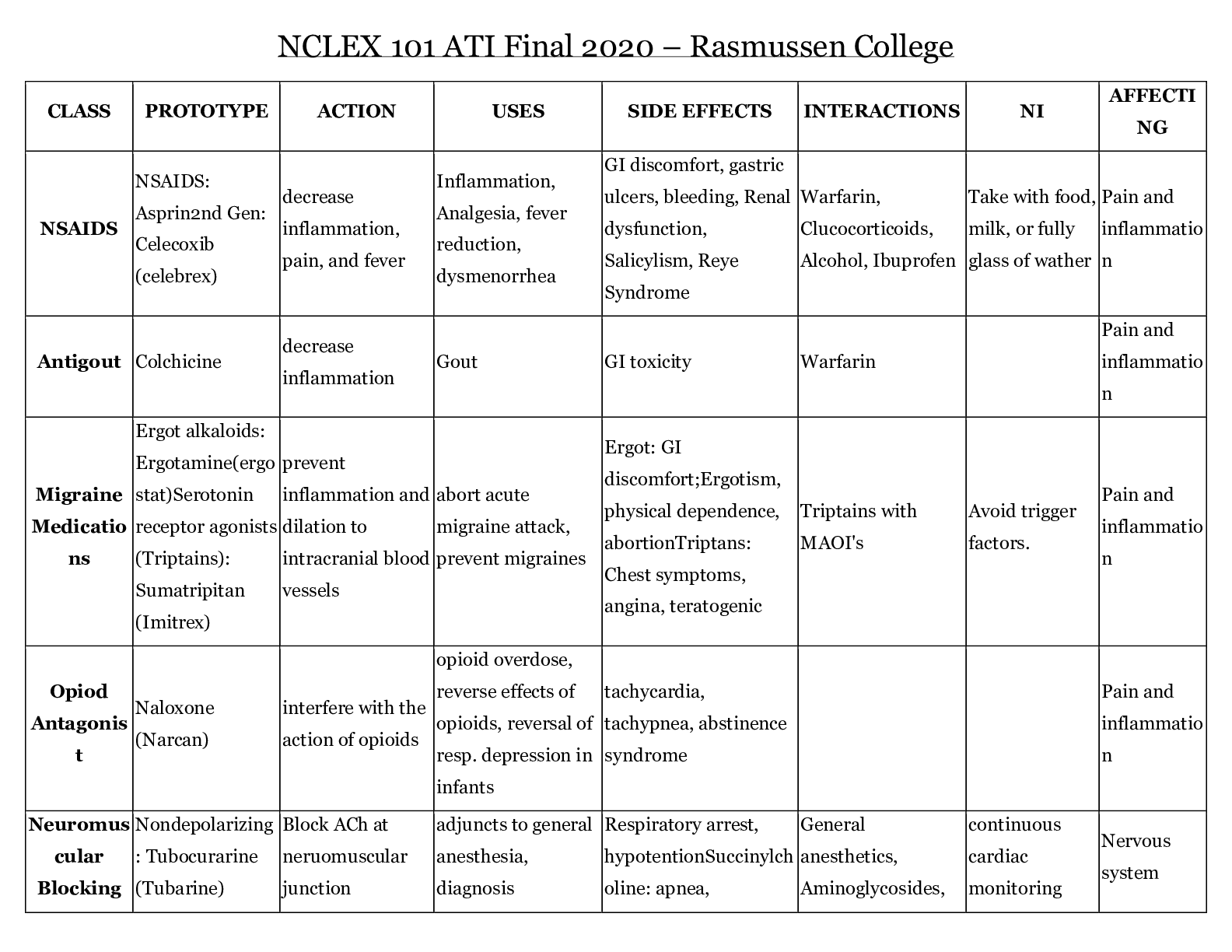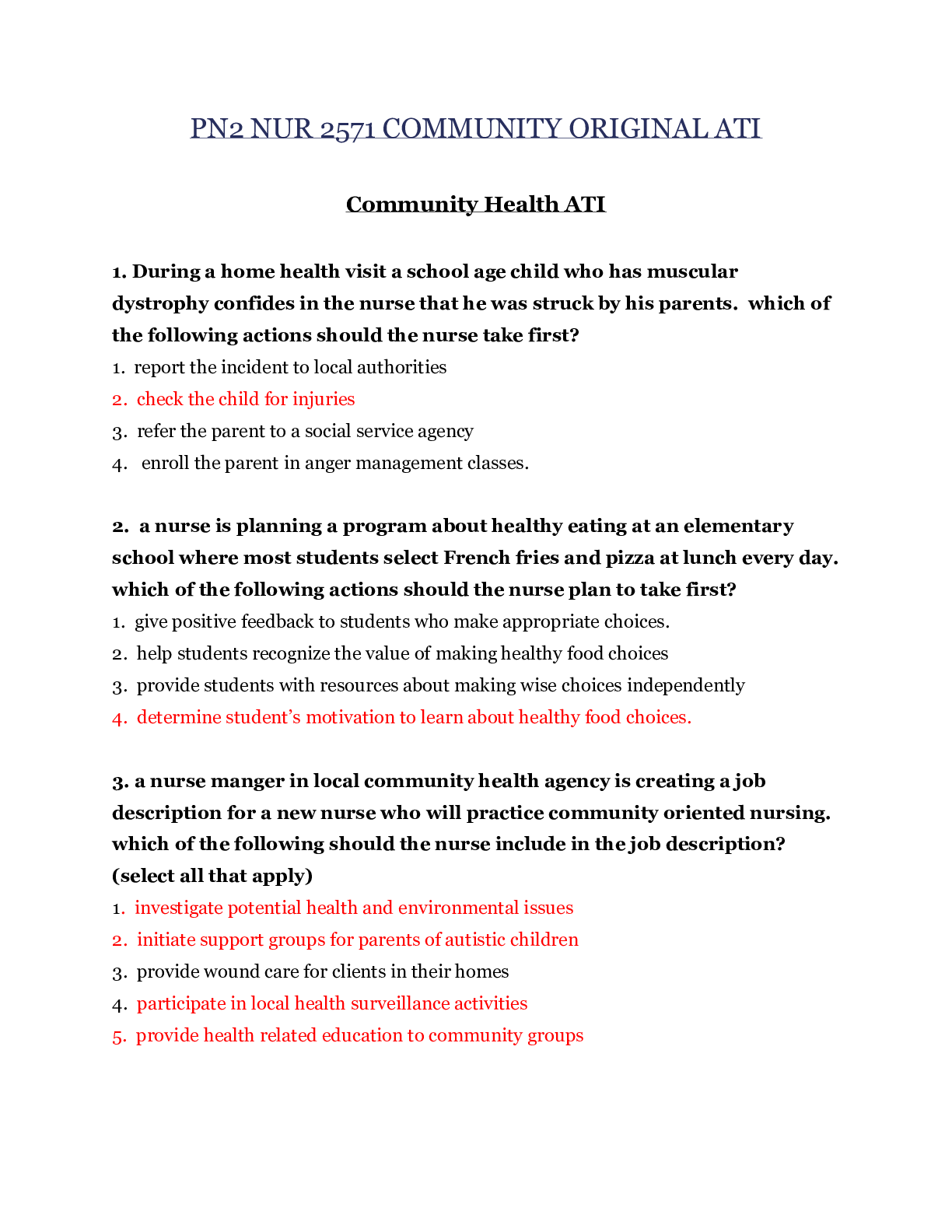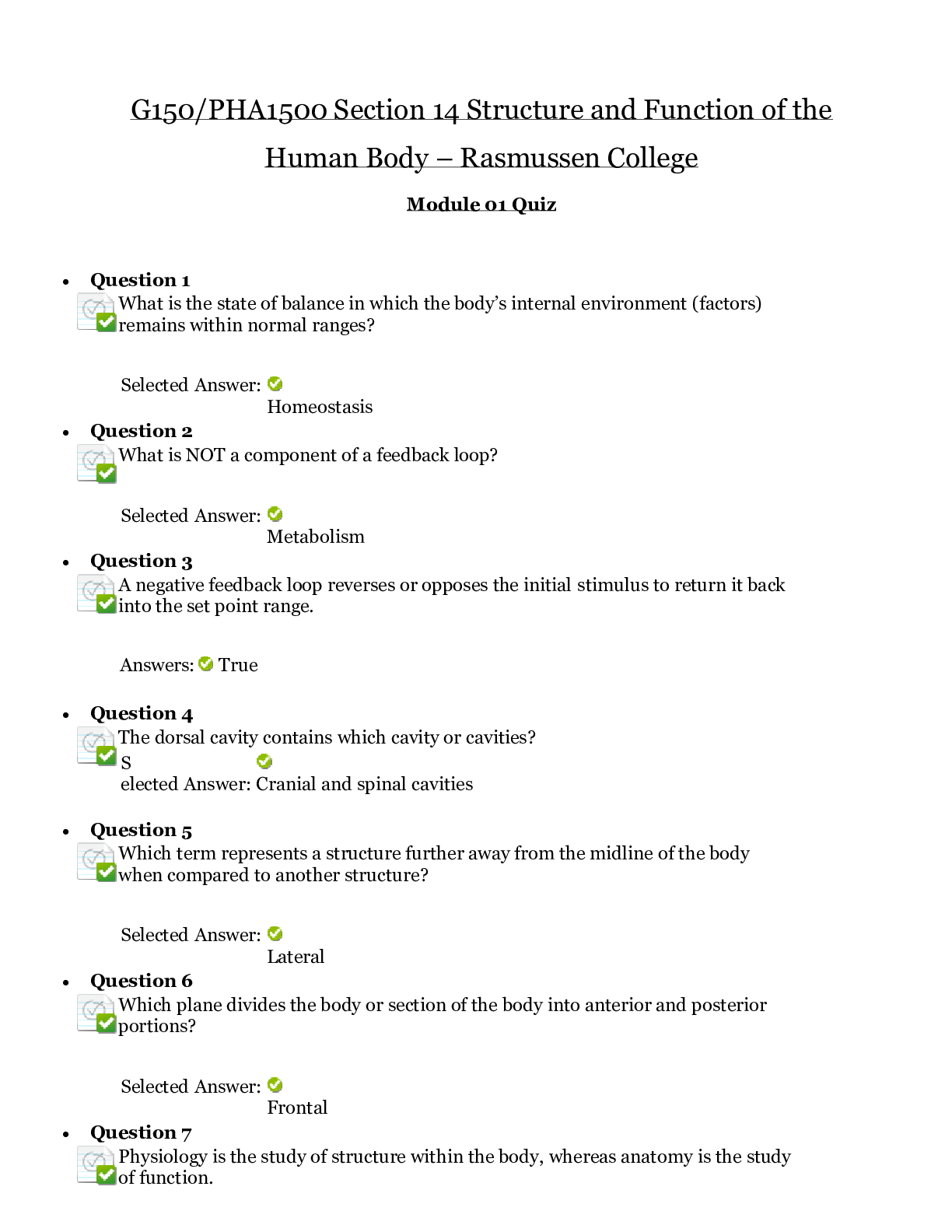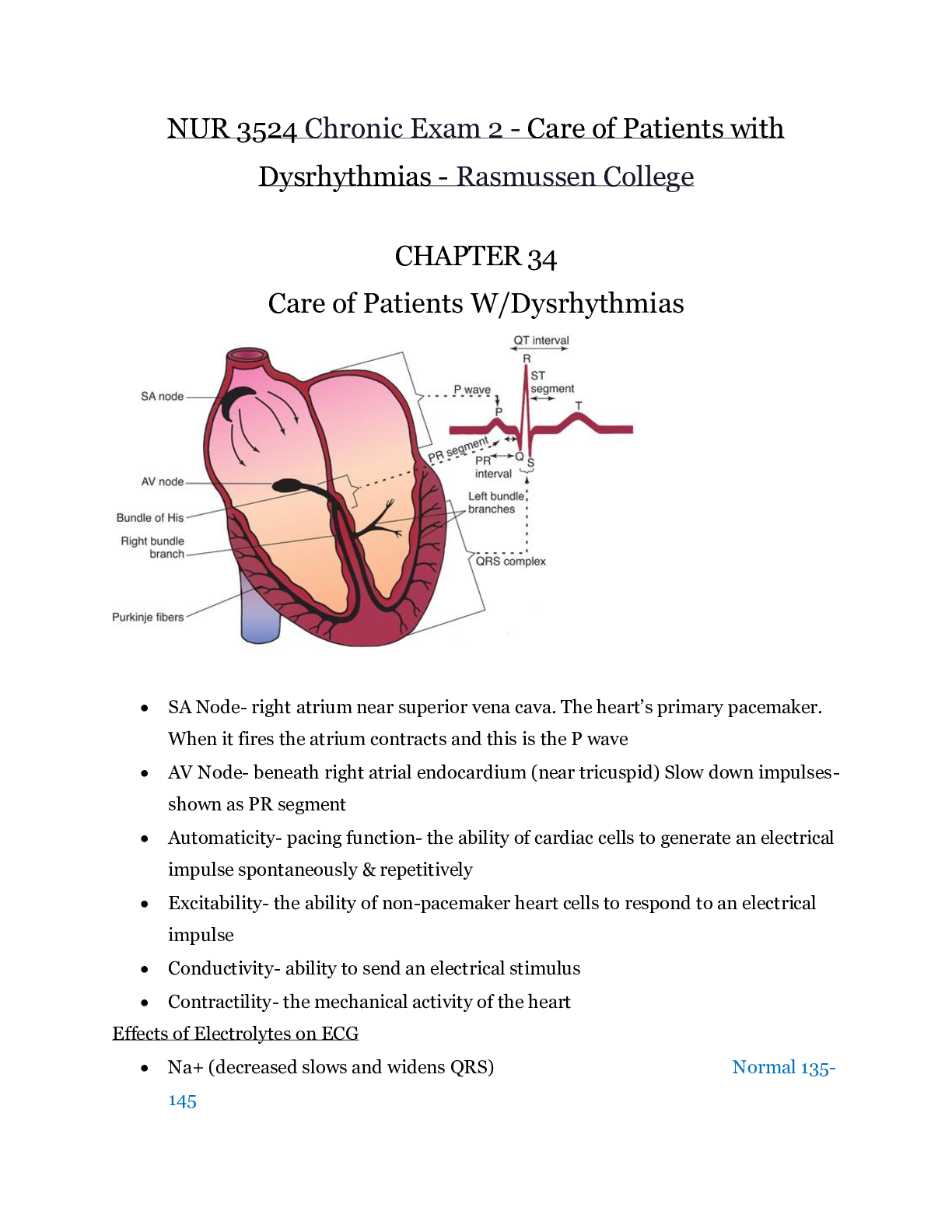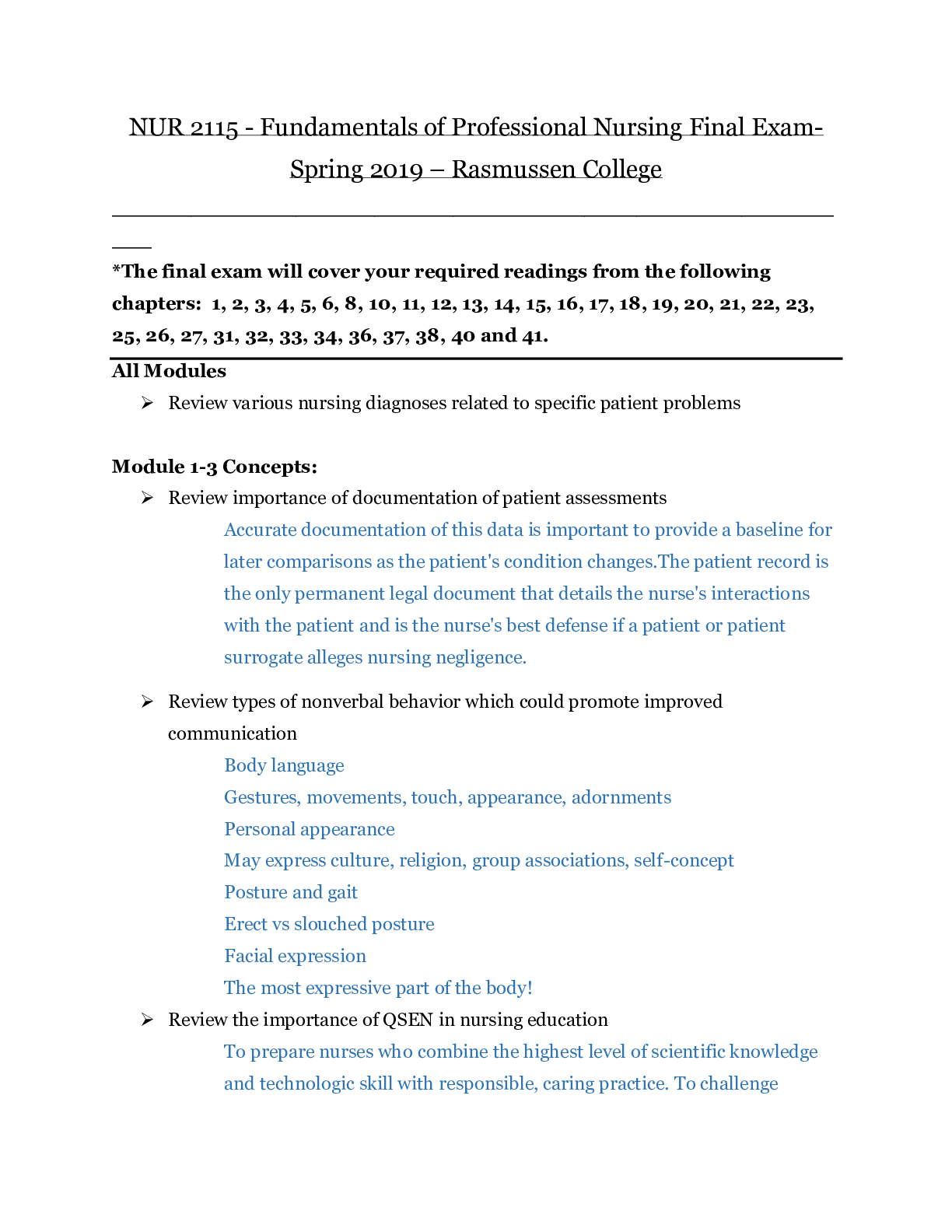*NURSING > EXAM > PN 1932 Family Final exam Review 2019 - Rasmussen College | PN1932 Family Final exam Review 2019 (All)
PN 1932 Family Final exam Review 2019 - Rasmussen College | PN1932 Family Final exam Review 2019
Document Content and Description Below
PN 1932 Family Final exam Review 2019 - Rasmussen College Reproductive cycle Menarche: beginning of menstruation- occurs about 11-15 yrs. • Early cycles are often irregular and may be anovul... atory (no ovulation occurs) • Regular cycles are usually established w/in 6 months to 2 years of the menarche • Average cycle, flow occurs every 28 days Climacteric: period of years during which the woman’s ability to reproduce gradually declines- aka perimenopausal pd- which extends for 2-8 yrs before menstruation stops Menopause: Cessation of menstrual periods for a 12month pd bc of changes in estrogen production (WHO-World Health Organization), decrease in estrogen specifically causes the following: • Changes in the menstrual cycle • Vasomotor instability (hot flashes) • Decreased moisture and elasticity of vagina that can cause dyspareunia (painful intercourse) • Other symptoms such as mood swings and irritability are also experienced. • The reproductive organs are estrogen dependent, leading to changes as the estrogen level declines. • There is less lubrication. Some women notice a change in libido (sexual desire) at this time. Testosterone levels are constant, not cyclical as are female hormones, although levels may decrease with age to 50% of peak levels by age 80 years. Some factors that can interfere with normal sperm formation and function include the following: • High scrotal temperature from hot tubs, saunas, or fever • Abnormal hormone stimulation • Infections • Anatomic abnormalities such as a varicocele (enlarged veins in the testicles) • Medications, illicit drugs, excessive alcohol intake • Exposure to toxins Antepartum Goals: • Promote the health of mom, fetus, newborn and family • Ensure a safe birth for mom and baby by promoting good health habits and reducing risk factors • Teach health habits that may be continued after pregnancy • Educate in pregnancy self-care • Develop partnership w/ parents and families to provide continuous and coordinated health care • Provide physical care • Prepare parents for the responsibilities of parenthood Prenatal teaching Signs of pregnancy • Presumptive: breast tenderness, linea negra, “morning sickness”, fatigue, frequent urination, having a late period, weird fluttering in the belly(quickening) • Probable: Goodell’s sign (softening of the cervix), Braxton hick’s, chadwell’s sign (bluish discoloration of the cervix, vagina and labia), hegar’s sign (softening of the lower uterine segment just above the cervix), McDonald’s sign (ease in flexing the body of the uterus against the cervix) ballotment, striae, pregnancy test • Positive: fetal heart sounds, ultrasound image, palpated fetal movements Nutrition: • Iron: food sources-30mg/day: (Heme-red and organ meat) (Nonheme-molasses, whole grains, iron-fortified cereals and breads, dried fruits, and dark-green, leafy vegetables) • Calcium: food sources-1200mg daily, (ex: Dairy, enriched cereals, legumes, nuts, dried fruits, broccoli, green leafy vegetables, and canned salmon and sardines that contain bones) Exercise: • Mild to moderate is beneficial, low impact NO temperature extremes like hot yoga or anything where falls are possible (biking) • Goal of exercise during pregnancy: Maintenance of fitness NOT improvement of fitness or weight loss Prenatal: first exam • Will need to obtain a full med/surg, OB, contraceptive, family and psychosocial history- physical includes pap smear • Labs: CBC w/ hgb, STD testing, blood typing, if they are RH +/-, urine tests • FHR (8-12 wks): usually better heard @ 12 wks (hard to hear w/ Doppler under 12 wks) can be seen around 7+ wks by ultrasound • US to determine viability-how many? Twins may be monozygotic or dizygotic, mono (one egg or identical twins) di= (2 eggs or fraternal twins) • Education for pregnant women traveling: frequent rest breaks & moving around, drink plenty of fluids, carry prenatal records, seatbelt (lap belt below abdomen), prior to third trimester is safest • Prenatal visits: every 4 weeks until 28 weeks, then every 2 weeks until 36-37 weeks, then weekly until delivery. Visits may occur more frequently for high risk pregnancies (gestational diabetes, gestational hypertension, etc.) - - - - - - - - - - - - - - - - - - Child w/ serious illness Cystic fibrosis • Pancreatic enzymes necessary to help with digestion • High fat/ salt foods • Breathing difficulty CPT • Infertility Sickle cell anemia • 1:4 • Immunize as early as possible • Don’t give iron • Encourage fluids to prevent dehydration • Children with SCD excrete higher volumes of urine compared with their peers because their kidneys cannot concentrate urine. When a child produces more urine than usual, they must also increase their fluid intake. This is particularly important in SCD, as dehydration can trigger pain crises. When a child with SCD is dehydrated, blood cells also become dehydrated and change shape, causing blood vessel blockage and acute pain. Make sure your child has easy access to water at all times. Congenital cardiac defects • Atrial Septal defect: opening btwn ventricles • Kids w/ CHD tire easily • Encourage rest/small frequent meals Child absue/legal issues Symptoms • Bruises in multiple stages of healing • Story does not match • Hovering parents • Child has sexual relationship at young age Risk factors • Abuse as a child • Low self-esteem • Poverty low education • High stress • Knowledge deficit of how to care for child How to handle the situation • Report ASAP • Be empathetic • Therapeutic communication Emancipated minor • Laws vary by state • Can sign for medical care of child and self The hospitalized/ER child Play: let child examine instruments if appropriate Education Cultural needs- determine what their needs are Fractures: watch for fracture on epiphyseal plates (growth plates) Nose bleed: epistaxis: keep calm and ice on, be careful not to tip head back to keep blood from dripping down the back of the child’s throat which can lead to vomiting Discharge: date and time, instructions, method of transport, adults accompany the child [Show More]
Last updated: 1 year ago
Preview 1 out of 17 pages
Instant download
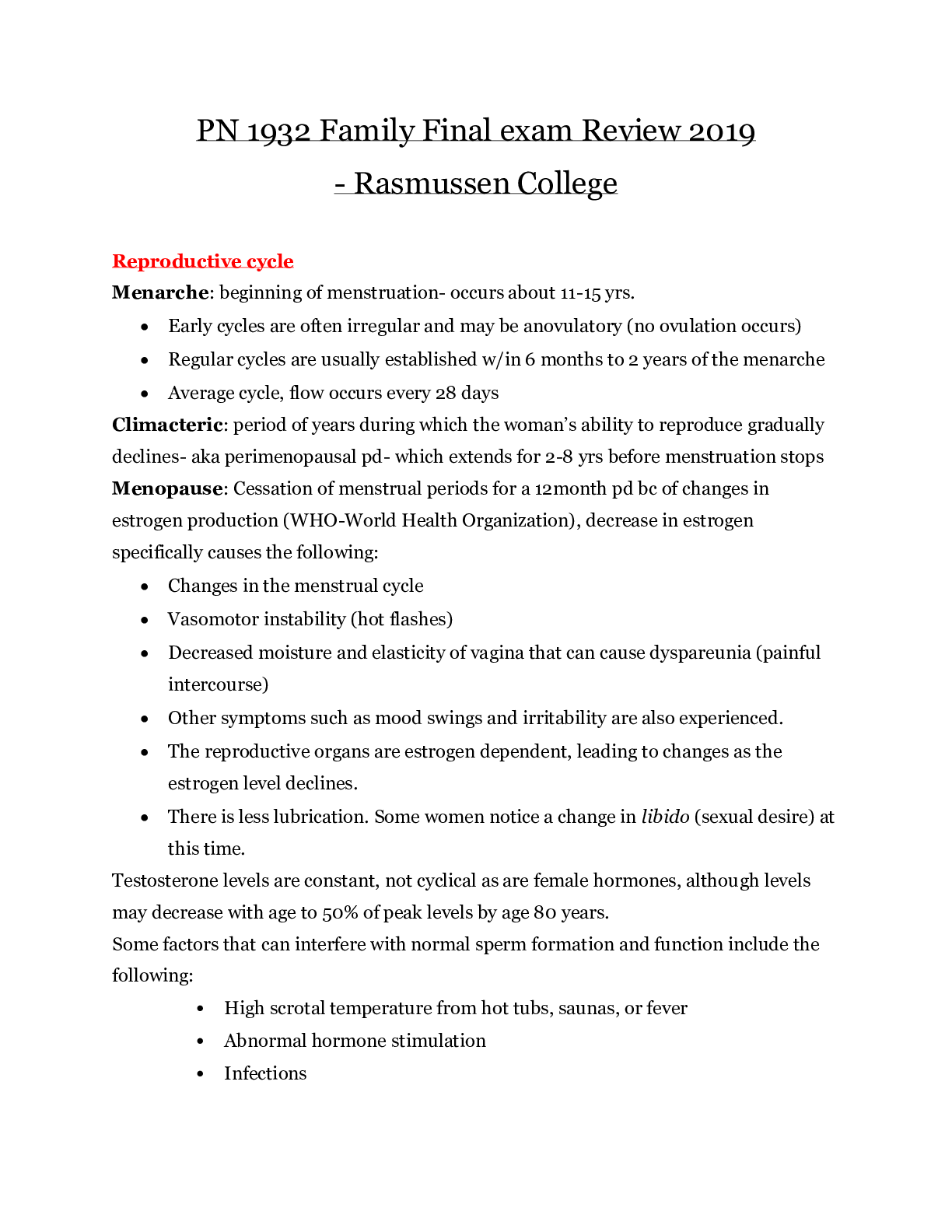
Buy this document to get the full access instantly
Instant Download Access after purchase
Add to cartInstant download
Reviews( 0 )
Document information
Connected school, study & course
About the document
Uploaded On
Aug 04, 2020
Number of pages
17
Written in
Additional information
This document has been written for:
Uploaded
Aug 04, 2020
Downloads
0
Views
43














